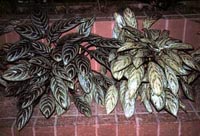Resource Library
Plant of the Week: Chinese Evergreens
The University of Arkansas System Division of Agriculture does not promote, support or recommend plants featured in "Plant of the Week." Please consult your local Extension office for plants suitable for your region.
Plant of the Week
Chinese Evergreens
Latin: Aglaonema commutatum

The success or failure of a houseplant usually boils down to two things -- selecting
the right plant for the location and then giving it the care it requires in that location.
One of the locations homeowners often face are those corners where there is just
not enough light for most plants to grow, but they want one anyway. The venerable
Chinese Evergreen seems to have been invented for dim corners.
The genus Aglaonema consists of around 30 species scattered in the tropics of south China and much of
the Malayan archipelago. These plants dwell on the jungle floor, so they are well
suited to life in low light areas. They are smallish, slow growing plants with thumb
size canes that fall over as the plant grows, giving some a rhizome-like growth habit.
The leaves of most forms are 8- to 10 inches long and often marked with bright patterns
of silver or white down the length of the leaf blade. These markings are not true
variegation -- just colorful markings to attract the attention of plant explorers.
The plants emerged from the jungles of southern Asia in the first half of the 19th
Century, being originally grown and described in Germany. While known in this country
by the early part of this century, they seem to have been little known at least by
the Yankees that wrote all of the garden books of the time. But after the Great War,
all of this changed. GI’s who served time in the South Pacific had seen the splendor
of tropical jungles and there was a general increase in the use of foliage plants
after the close of the war.
For a plant to survive in a low light environment, it must produce more energy in
photosynthesis than it consumes in respiration. Or, in the language of the everyday
consumer, it must earn more than it spends. The break even point for Aglaonema, called
the light compensation point where income equals outgo, is very low -- around 10 foot
candles. The average interior room has from 20 to 60 foot candles and a good reading
location will have 100 foot candles. Your local shopping mall usually has about 200
foot candles. If only 10 foot candles of light is available, an Aglaonema won’t grow
but it won’t die. It will just sit there awaiting an occasional dusting.
Even when light levels are above the absolute minimum, Aglaonemas are slow growing.
They also hate cold -- in fact exposing these true tropical plants to temperatures
below 55 degrees will usually kill them. Because they are slow growing, long lived
and tolerant of low light conditions they make excellent houseplants.
Aglaonemas should be allowed to dry slightly between waterings, but never to the
point of wilting. If repotting is needed, delay until the longer days of spring so
that the plant has conditions favorable for a growth spurt. Mealybugs and occasionally
brown fern scale are the main problem found on these plants.
By: Gerald Klingaman, retired
Extension Horticulturist - Ornamentals
Extension News - December 10, 1999
The University of Arkansas System Division of Agriculture does not maintain lists of retail outlets where these plants can be purchased. Please check your local nursery or other retail outlets to ask about the availability of these plants for your growing area.